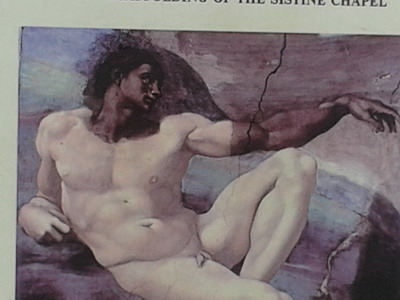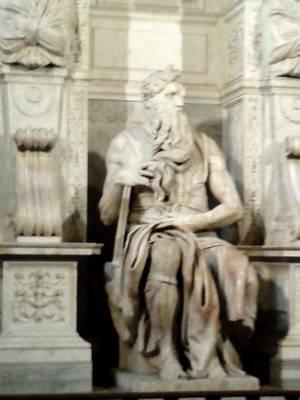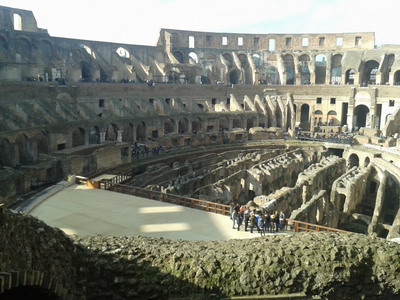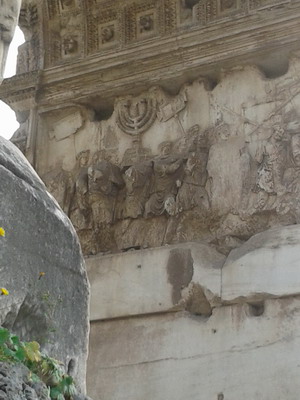REFLECTIONS
ON JERUSALEM IN ROME
After
a visit to Rome by Doreen in January 2016
When
we visited Rome for a bridge meeting I had
many hours to again explore the city. Viewing the archaeological
remains and
churches is a contra punt to Israel's history. Walking through the
Vatican
Museum on the way to the Sistine Chapel is mindboggling. The sheer
number of
works of art collected throughout the centuries by the popes is
staggering. A
thought occurred to me, that popes showed their power through art,
rabbis
through learning. But both hold an absolute power over their followers.

Nowhere
is Creation more dramatically conceived
than in the recently cleaned frescoes by Michelangelo on the ceiling of
the Sistine
Chapel. How breathtaking is the moment before the creation of
Adam.
Adam, eyes open, languidly stretching toward life while God surrounded
by
cherubs leans towards him, enclosed within a form suggesting the brain
(for a
detailed discussion: Creation of Adam www.wellscorp.com ).
Others point to Adam’s bellybutton and red
and blue cords around the figure of God, suggesting the womb.
On
the ceiling are the prophets from the bible. Of
course, The Last Judgement is riveting. It
is interesting that the bits of cloth hiding sexual organs were later
added as
the many nudes were seen to be unfitting in a holy chapel. Below on the
walls
are frescoes by Botticelli, Perugino and others, of events in the life
of Moses
with parallels (typology) to Jesus’ life.
I was sorry that I did not bring binoculars as many paintings
are high
above on ceilings of churches.
Continuing
to St. Peter's Basilica is
Michelangelo's La Pieta. Done when he was 24, it has no parallel. It was carved from a single slab of Carrara
marble. The Holy Land has paintings but few statues and has no
corresponding
representation. In the Church of the
Holy Sepulcher in Jerusalem is Our Lady of Sorrows with a sword to her
heart,
commemorating Mary taking Jesus down from the Cross. It is between the
XIth and
XII Stations of the Cross. Together with La Pieta and Stabat Mater,
these three
subjects are the most common commemorations of the event; La Pieta
dates from
the 15th Century, long after important churches were
established in
the Holy Land. Also in St Peter’s is the famous statue of St Peter who
at
Caesarea Phillipi or Banias, as we know it today, professed Jesus as
Christ and
was given the keys to heaven. This is the basis for popes being seen as
the
continuing representatives of Peter. The only statue I know of Peter in
Israel
is at Capernaum by the Kinneret.

San
Pietro in Vincoli is above the Coliseum, a little off the beaten
track, but
definitely worth the climb to see the statue of Moses by Michelangelo.
Originally commissioned to be part of the tomb of Pope Julius II
standing above
the tomb, today it is on the floor. The horns of Moses are usually
described as
a mistranslation of ‘karnayim,’ beams of light, touched by God
(paralleled later
by Jesus with light around head). There is a suggestion that the horns
were not
meant to be seen but to reflect light when Moses was supposed to be
high above
the tomb.
It is
an arresting portrayal in stone that
seems alive and pliable. Moses’ right hand and arm are both resting on
and
guarding the tablets of law; the hand is relaxed suggesting a complete
intimacy
and familiarity with the tablets. His body
is relaxed with one hand playing with his beard even though the
position of his
feet suggests he is prepared to stand up in a second. But Moses' gaze
is
hypnotic, in total contrast to the rest of his body. His face is so
intense and
fierce - watching to see if children of Israel will return to
worshipping
golden calves?
Researchers
question whether this is Moses after
receiving
the tablets for the first or second time, as they seem to be blank. I
would
like to think that the Ten Commandments are etched inside. Freud,
amongst
others, spent days trying to analyze this statue and came to some
surprising
conclusions!

We
have theaters and stadia in Caesarea and Bet
Shean, but nothing equals the Coliseum. It was built by Vespasian who
led the Roman campaign to
suppress the
4-year Jewish Revolt in Judea. When he was declared Emperor his son
Titus
continued his work.. The Coliseum is 4 stories high, and could seat
55,000
people within minutes through 80 arched entrances. Our daughter Vered
pointed
out they didn't need to find parking! Gladiatorial fights and wild
animals -
bread and circuses - kept the public happy. Two floors below the arena
animals
were kept in cages. They were winched up when due to fight and appeared
dramatically through trap doors. The arena floor was covered in sand to
absorb
blood from animals and gladiators. We too have a gladiator, Resh
Lakish. He was
known for his extraordinary strength and was both a bandit and a
gladiator who
worked the circuses fighting wild beasts. When he mistakenly took Rabbi
Yohanan
for a woman, he jumped into the water next to him. Rabbi Yohanan, who
was very beautiful,
encouraged him to study the Torah and he became a great sage while
living in
Zippori. Thumbs up for the gladiator-sage!
In the Forum the first of the triumphal arches is the Arch of
Constantine There
is also the Basilica of Maxentius and Constantine. Constantine, in
312CE, about
to fight the Battle of Milvan Bridge against Maxentius for supreme
control of
the Roman Empire, is said to have had a vision that if he had the Chi
Rho (symbol
of Christ) on his standard he would be victorious under divine
protection. And
he did. He subsequently legalized Christianity which later became the
official
religion of the Roman Empire, replacing paganism. A common symbol
today, it is
highly visible on the front of the Church of the Annunciation in
Nazareth.
Constantine himself converted to Christianity only on his deathbed.

Then
there is Titus' Arch, named after the man
who destroyed the Second Temple and Judea’s independence. It is the
most
meaningful for us. The Arch was built by Titus' brother in 81 CE to
honour his
father Emperor Vespasian and his brother Titus. Carved inside
the arch,
on one side is Titus with horses and carriage in his Triumph in Rome.
On the other
side are Roman soldiers carrying spoils of Temple: the menorah, silver
trumpets,
incense shovels and the shewbread table. It is the last depiction of
the menorah
by some-one who saw it. Graffiti in the Old City of Jerusalem and
elsewhere
depicts the menorah as having three legs. Puzzling is the menorah in
the Arch
of Titus in that it has a solid base with pagan symbols on it. Did the
Romans
change the base to make its transport to Rome easier? Or
was it Herod? In any case it is this
menorah that has become part the symbol of the State of Israel as well
as the Diaspora
and has a prominent place in the Diaspora Museum in Tel Aviv.
The
Forum of Augustus celebrates the victory of
Octavian over Brutus and Cassius, the assassins of Julius Caesar. I saw
nothing
commemorating Battle of Actium and Octavian's victory over Mark Anthony
and
Cleopatra.
The Pantheon was built by Hadrian. Light and airy its only light source
comes from
the oculus (aperture) at top. Its intricate coffered design is
suspended
in huge dome, even today the largest unreinforced concrete structure in
the
world. Rafael’s tomb is in the Pantheon. Hadrian is known for Hadrian’s
Wall
which became the northernmost limit of the Roman Empire.
For
Jewish people it was he, Hadrian, who so
viciously suppressed the Bar Kochva Revolt when he decided to build a
pagan
temple in place of the destroyed Temple II. He is described in Hebrew
as “shehik
atzamot” (the bone crusher) and is
remembered
as a cruel ruler who actually flattened Jerusalem, expelled the Jews
from their
capital and rebuilt a pagan city in its place called Aelia Capitolina.
He also
tried to rub out from memory the name of Judea, changing it to Syria
Palestrina,
after the Philistines, the hated enemy of biblical times.
Hadrian expelled the Jews from Jerusalem,
forbad circumcision and the teaching and practice of Judaism, trying to
eradicate it. Hadrian is buried in the massive Castel Saint Angelo by
the River
Tiber. Currently (2016) there are three statues of him on display at
the Israel
Museum.
Via
Dei Fori Imperiali was built by Mussolini
for parades. Along it today by Trajan's markets are statues of Roman
Emperors,
including Antoninus.
When
Hadrian’s decree against circumcision of
babies was still in force, baby Yehuda was circumcised, despite the
harsh
punishment awaiting him and his parents. Mother and baby were sent off
to Rome
to stand before the emperor. On the way the Jewish mother met a Roman
mother
who graciously suggested swapping her uncircumcised son with that of
baby
Yehuda, thus saving both mother and child from harsh punishment.
Tradition
continues that the babies remained good friends through their
illustrious
careers – the Jewish baby was Rabbi Yehuda HaNasi, the redactor of the
Mishnah,
and the other baby became the Roman Emperor Antoninus, whose statue you
can find
among the statues of emperors on the Imperial Way.
San
Croce in Gerusalemme. Queen Helena, who
unlike her son the Emperor Constantine, was Christian. She made the
arduous
journey to Jerusalem. There she asked the questions "Where..?" Where
was Jesus born, died, crucified and from where did he ascend to heaven?
I’m not
sure if it was tourist guides or church fathers who gave her the
information,
but at the site of the crucifixion, where the Church of the Holy
Sepulcher stands
today tradition maintains they found three crosses, nails and part of
the titulus,
the
tablet setting forth in three languages the reason for the
condemnation. The cross remained in Jerusalem but Helena
returned
with part of the Cross and part of Pontius Pilate’s inscription INRI (which
I didn’t see) which are the relics of
San Croce today.
If
you go to very bottom of the Church of the
Holy Sepulcher in Jerusalem,
down the steps past the Armenian chapel you come to the Chapel of the
Finding
of the True Cross. Tradition holds that
three crosses were found (of Jesus and the two thieves) and tested.
When a dead
boy was brought back to life the True Cross was identified. It was subsequently captured by the Persians
in 614 CE but returned by Heraclius the Byzantine emperor. During the
Crusader
period a sliver of the wood embedded in a golden cross was taken to bolster the Crusader forces at the
Battle of Hattin and captured by Saladin. There are reports that the
last
mention of it is that it was displayed in the streets of Damascus and
afterwards it disappeared.
And
to end it off, who cannot eat pasta, pizza
or drink wine without remembering Italy. Our best recommendation it to
eat at
Restaurant 34 near the Spanish Steps. A great, very reasonable dining
experience.



